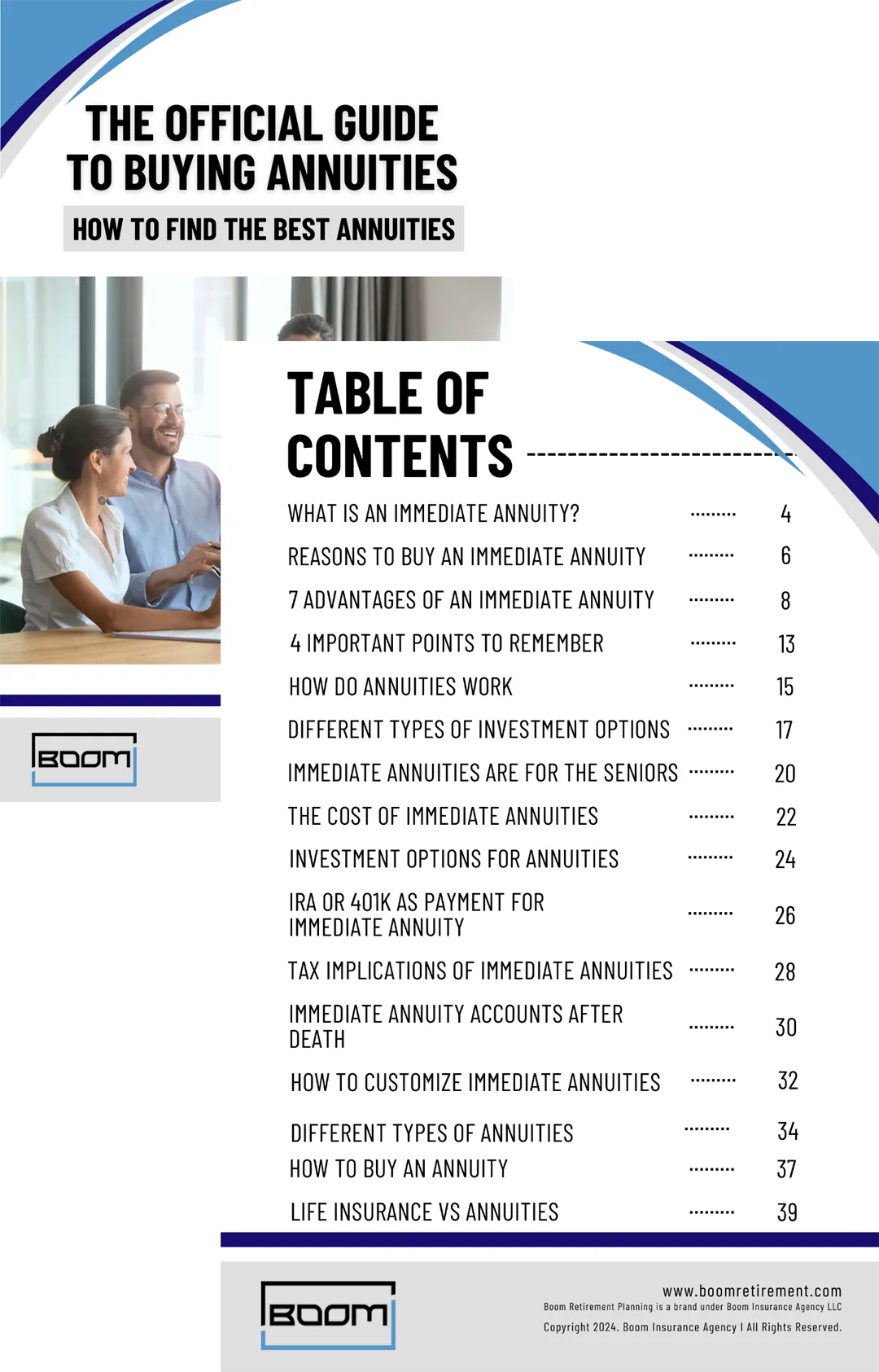
BOOM RETIREMENT SOLUTIONS
Strategies for Boosting Retirement Income

Top Retirement Cash Flow Risks
Why you need this Retirement Toolkit
Will outlive your retirement savings?
Will taxes and inflation erode your Retirement Nest Egg?
Will you head into retirement using an Accumulation Strategy or a Decumulation Strategy?
Will you maintain your lifestyle in a market downturn?
Are you prepared for RMD's and IRMAA?
BOOM RETIREMENT PLANNING
Strategies for Boosting Retirement Income
If You Ask 50 Financial Advisors,
"What is the best way to retire?".
You will get 50 different answers!
That is because despite all their training and certifications,
financial advisors each bring their own perspectives, experiences, and
biases to the table, leading to varied approaches and strategies tailored to their
unique understanding of the market, client needs, and risk tolerance.
Economic Science and Math proves...
There is Only One Optimal Way to Retire
Over 6 Decades of Research Created the 7 Steps Below.
Develop a Plan: Assess your financial situation, retirement goals, income sources and monthly budget for expenses.
Secure Lifetime Income: Consider products like private pensions for guaranteed income.
Maximize Social Security: Optimize benefits by understanding your options; delaying to 67 or 70 can help.
Diversify Investments: Build a balanced portfolio—30% cash value life insurance, 30% lifetime income, 40% growth assets.
Prepare for Health Care Costs: Budget for health expenses, including long-term care, which most seniors will need.
Use Tax-Efficient Strategies: Consider Roth conversions to reduce retirement taxes.
Stay Active and Engaged: Pursue activities for mental, physical, and emotional well-being in retirement.
Our Blog

Understanding Participation Rates for Fixed Indexed Annuities: A Comprehensive Guide
Understanding Participation Rates for Fixed Indexed Annuities: A Comprehensive Guide
Fixed Indexed Annuities (FIAs) have become increasingly popular as a retirement planning tool, combining the safety of fixed annuities with the growth potential of variable annuities linked to market indexes. One of the critical components influencing the returns on FIAs is the participation rate. In this comprehensive guide, we'll dive deep into what participation rates are, how they work, and their impact on your annuity investment.
What Are Fixed Indexed Annuities (FIAs)?
Before delving into participation rates, it's essential to understand what Fixed Indexed Annuities are. FIAs are insurance products that provide interest earnings based on the performance of a specified market index, such as the S&P 500. Unlike direct stock market investments, FIAs offer a level of protection against market downturns while still allowing you to benefit from market upswings.
Defining Participation Rates
The participation rate is a fundamental concept in Fixed Indexed Annuities. It determines the percentage of the index's gain that will be credited to your annuity. For instance, if the index increases by 10% and the participation rate is 80%, your annuity would be credited with an 8% gain.
How Participation Rates Work
1. Calculating Gains: Participation rates come into play when calculating the interest credited to your annuity based on the performance of the underlying index. Let's break it down with an example. Suppose your FIA is linked to the S&P 500 index, which has grown by 10% over a year. If your participation rate is 70%, you will receive 70% of the 10% gain, which equates to 7%.
2. Impact of Participation Rates: Participation rates directly impact your potential earnings. Higher participation rates mean a more significant portion of the index's gains is credited to your account, increasing your returns. Conversely, lower participation rates reduce your potential earnings.
Factors Influencing Participation Rates
Several factors can influence the participation rates set by insurance carriers:
1. Market Conditions: The prevailing economic environment and market volatility can impact participation rates. During stable economic periods, carriers might offer higher participation rates to attract customers.
2. Carrier's Financial Health: The financial stability and risk management strategies of the insurance carrier also play a role. Strong, financially healthy carriers might be able to offer more competitive participation rates.
3. Product Features: Specific features of the FIA, such as caps, spreads, and fees, can affect participation rates. For instance, an annuity with a high cap rate might have a lower participation rate to balance the carrier's risk exposure.
4. Regulatory Environment: Insurance regulations and guidelines can influence how carriers set participation rates. Compliance with regulatory requirements ensures that carriers maintain solvency and protect policyholders' interests.
Comparing Participation Rates Across Different FIAs
When evaluating different Fixed Indexed Annuities, comparing participation rates is crucial. Here are some steps to help you make an informed decision:
1. Review Product Brochures: Start by reviewing the product brochures and literature provided by the insurance carriers. These documents typically outline the participation rates and other essential features of the FIA.
2. Ask Questions: Don't hesitate to ask your financial advisor or the insurance agent for clarification on participation rates. Understanding the nuances of how they are applied can help you make a better choice.
3. Consider the Overall Package: While participation rates are essential, they are just one piece of the puzzle. Evaluate other factors such as cap rates, spreads, fees, and the financial strength of the insurance carrier.
Participation Rates vs. Cap Rates and Spreads
It's essential to differentiate between participation rates, cap rates, and spreads, as they all influence the returns on your FIA.
1. Cap Rates: The cap rate is the maximum rate of interest your annuity can earn in a given period, regardless of how much the index increases. For example, if the index grows by 10% but your annuity has a cap rate of 5%, your credited interest will be capped at 5%.
2. Spreads/Margins: A spread or margin is a specified percentage deducted from any gain in the index. For instance, if there's a 10% gain and a 2% spread, your annuity would be credited with an 8% gain.
Participation rates, cap rates, and spreads can interact in complex ways. An FIA might have a high participation rate but a low cap rate or a high spread, which could limit your overall returns. Understanding these interactions is crucial for making an informed decision.
Pros and Cons of High Participation Rates
High participation rates can be attractive, but they come with their own set of pros and cons:
Pros:
Higher Potential Returns: High participation rates mean you receive a larger portion of the index's gains, potentially leading to higher returns.
Competitive Edge: FIAs with high participation rates can be more appealing compared to other investment options, making them a good choice for growth-oriented investors.
Cons:
Trade-offs: High participation rates might come with trade-offs such as lower cap rates or higher spreads, which can limit your overall returns.
Risk Management: Insurance carriers might adjust other features of the annuity to manage their risk, potentially impacting your investment.
Real-World Examples
To better understand how participation rates work in practice, let's look at a couple of real-world examples:
Example 1:
Index Performance: S&P 500 increases by 12%
Participation Rate: 80%
Cap Rate: 10%
Spread: None
In this example, the annuity would be credited with 80% of the 12% gain, resulting in a 9.6% credited interest. However, since there is a cap rate of 10%, the credited interest remains 9.6%.
Example 2:
Index Performance: S&P 500 increases by 8%
Participation Rate: 90%
Cap Rate: None
Spread: 2%
Here, the annuity would be credited with 90% of the 8% gain, resulting in a 7.2% gain. After applying the 2% spread, the final credited interest would be 5.2%.
How to Choose the Right FIA Based on Participation Rates
When selecting an FIA, it's essential to consider your financial goals, risk tolerance, and the overall features of the annuity. Here are some tips to help you choose the right FIA based on participation rates:
1. Assess Your Risk Tolerance: Consider how comfortable you are with market fluctuations and potential changes in interest credited to your annuity.
2. Set Clear Goals: Determine your financial goals, whether it's preserving capital, generating steady income, or maximizing growth. Your goals will influence the type of FIA that suits you best.
3. Compare Multiple Products: Don't settle for the first FIA you come across. Compare multiple products from different carriers to find the best participation rates and overall features.
4. Seek Professional Advice: Consult with a financial advisor who can provide personalized recommendations based on your financial situation and goals.
Conclusion
Participation rates are a critical component of Fixed Indexed Annuities, directly influencing your potential returns. Understanding how these rates work, their interaction with other features like cap rates and spreads, and the factors that influence them can help you make an informed decision when selecting an FIA. By carefully considering participation rates and other essential features, you can choose an annuity that aligns with your financial goals and provides a balanced approach to growth and security in your retirement planning.
As always, it's essential to consult with a financial advisor or insurance professional to ensure that you fully understand the terms and conditions of any annuity product before making a decision. With the right information and guidance, you can make confident choices that support a secure and prosperous retirement.
Taxation can play a substantial role in determining
the overall value of your retirement portfolio
How are your current retirement income sources taxed?
Social Security
Qualified Accounts
Non-Qualified Accounts
Social Security is a federal government program in the United States that provides financial benefits to eligible individuals, primarily retirees, disabled individuals, and their families. It is funded through payroll taxes collected under the Federal Insurance Contributions Act (FICA) and the Self-Employment Contributions Act (SECA).
Key components of Social Security include:
Retirement Benefits: These benefits are available to workers who have paid into the Social Security system through payroll taxes during their working years. Individuals can start receiving reduced retirement benefits as early as age 62, but full benefits are available at the full retirement age, which varies depending on the year of birth. Delaying benefits beyond full retirement age can increase the monthly benefit amount.
Disability Benefits: Social Security Disability Insurance (SSDI) provides benefits to individuals who are unable to work due to a qualifying disability. To be eligible, individuals must have a sufficient work history and meet specific medical criteria.
Survivor Benefits: These benefits are paid to the surviving spouses, children, or dependents of deceased workers who paid into the Social Security system. The amount of the benefit depends on the deceased worker's earnings record.
Supplemental Security Income (SSI): Although administered by the Social Security Administration, SSI is a separate program funded by general tax revenues (not Social Security taxes). It provides financial assistance to elderly, blind, or disabled individuals with limited income and resources.
Social Security is a critical component of retirement planning for many Americans, providing a safety net to ensure a basic level of income in retirement, during periods of disability, or after the death of a family member.
Social Security benefits may be taxed based on your combined income, which includes adjusted gross income, nontaxable interest, and half of your Social Security benefits. Depending on your income level, up to 85% of your benefits could be subject to federal income tax.
A qualified account is a type of retirement savings account that offers tax advantages, typically regulated by the IRS under specific sections of the tax code. Contributions to qualified accounts are often tax-deferred, meaning that contributions are made with pre-tax dollars, reducing the individual's taxable income in the year of the contribution. Taxes on contributions and investment earnings are deferred until withdrawals are made, usually in retirement.
401(k) plans
403(b) plans
457 plans
Traditional IRAs
SEP IRAs
SIMPLE IRAs
Self Directed IRAs
Pensions
Annuities
Withdrawals from these accounts are generally subject to income tax, and there may be penalties for early withdrawals before a certain age (usually 59½). Additionally, qualified accounts are subject to Required Minimum Distributions (RMDs) once the account holder reaches age 73 (if born before 1960).
Required Minimum Distributions (RMDs) are the minimum amounts that retirees must withdraw annually from their tax-deferred retirement accounts, such as traditional IRAs and 401(k)s, starting at age 73 (as of 2023). The amount of the RMD is calculated based on the account balance and the account holder's life expectancy. Failing to take RMDs can result in significant tax penalties, including a hefty excise tax on the amount that should have been withdrawn.
A non-qualified account is a type of investment account that does not have the same tax advantages or restrictions as qualified retirement accounts. Unlike qualified accounts, contributions to non-qualified accounts are made with after-tax dollars, meaning there's no tax deduction for contributions.
Examples of non-qualified accounts include:
Brokerage accounts
Mutual fund accounts
Certificates of deposit
Savings accounts
Roth IRA
Cash Value Life Insurance
Annuities
These accounts are often used for general savings and investments outside of retirement, offering more flexibility in terms of contributions and withdrawals, but without the tax advantages of qualified accounts.
The exception is the Roth IRA in which the principal, interest, earnings and dividends are all tax-free. Roth IRAs are also not subject to RMD's.
A Roth conversion is the process of transferring funds from a Qualified retirement accounts into a Roth IRA (Non-Qualified Account). The converted amount is subject to income tax in the year of the conversion, but future withdrawals from the Roth IRA are tax-free, provided certain conditions are met. This strategy is often used to reduce taxable income in retirement and to avoid required minimum distributions (RMDs).

Boom Final Expense is a brand under Boom Insurance Agency LLC
©Copyright 2023| Boom Insurance Agency. All Right Reserved

Boom Retirement Planning is a brand under Boom Insurance Agency LLC
©Copyright 2024| Boom Insurance Agency. All Right Reserved





